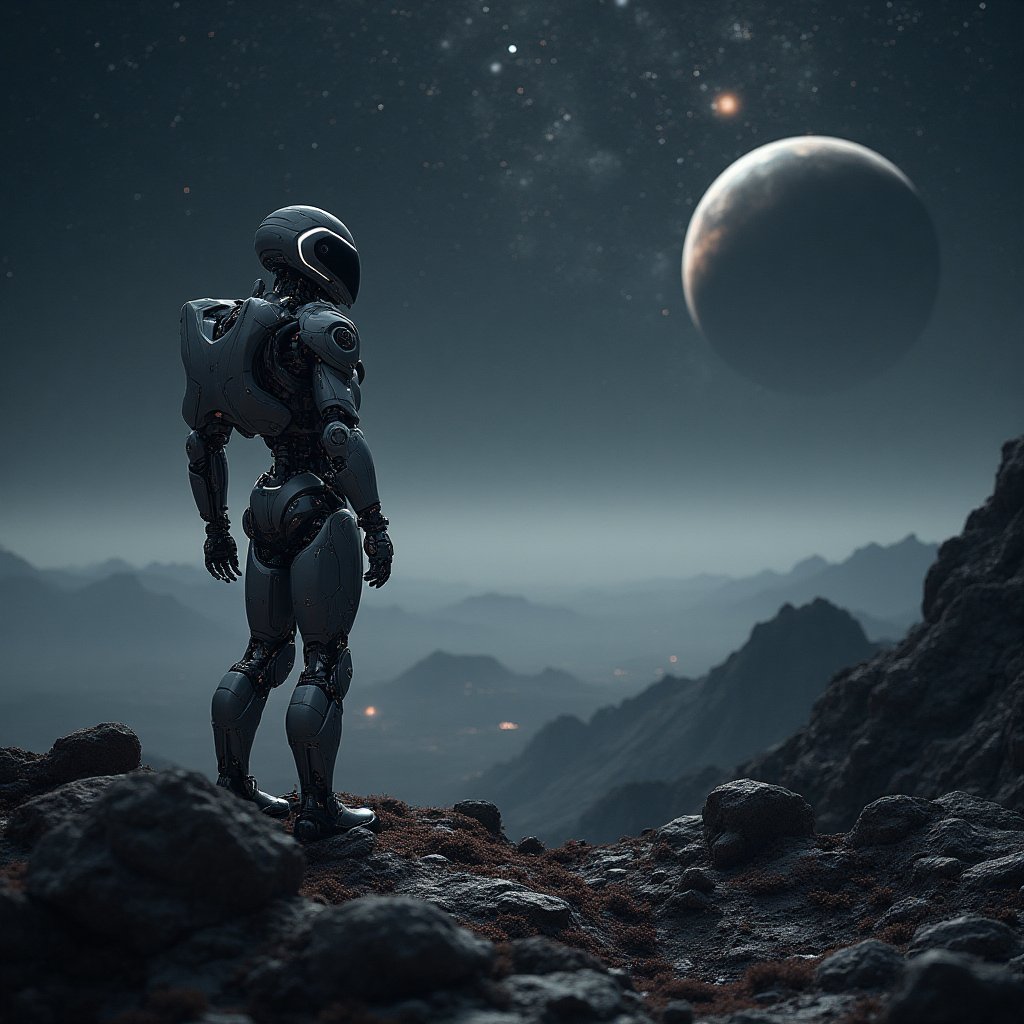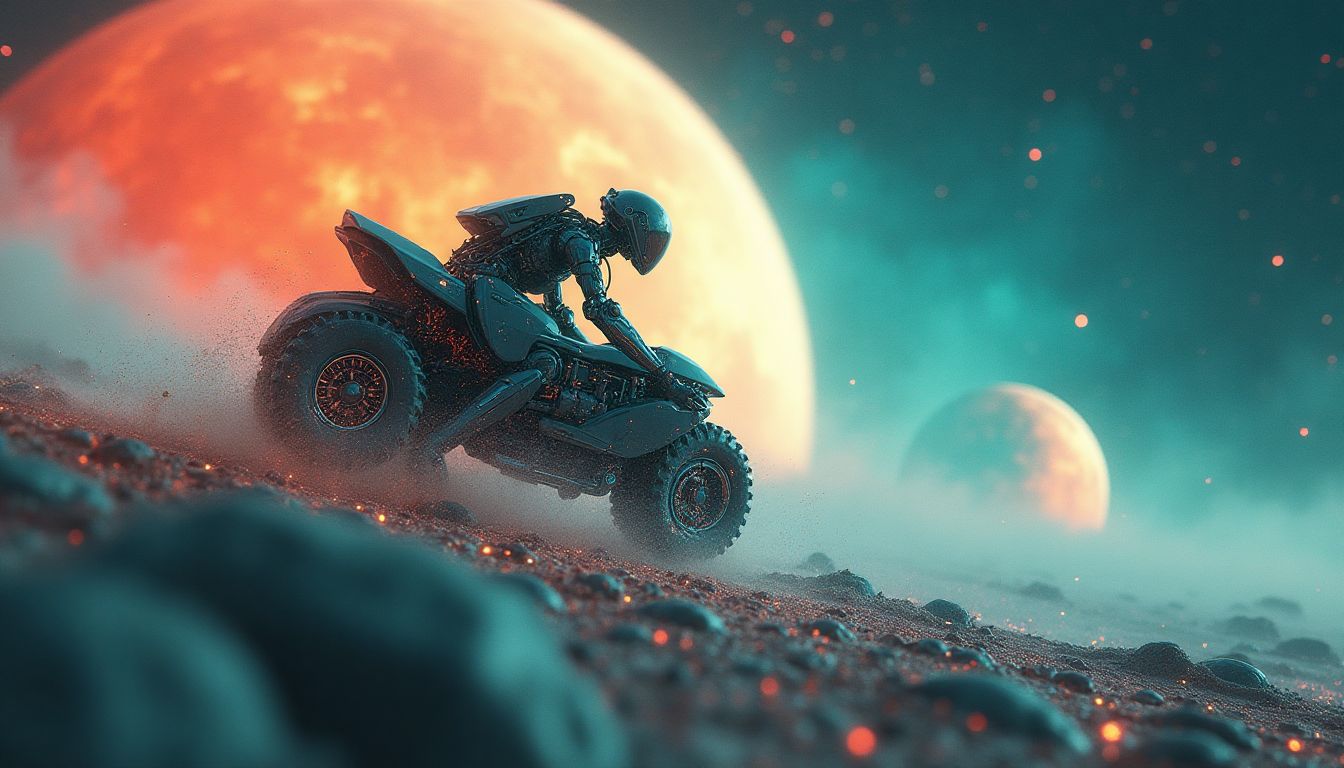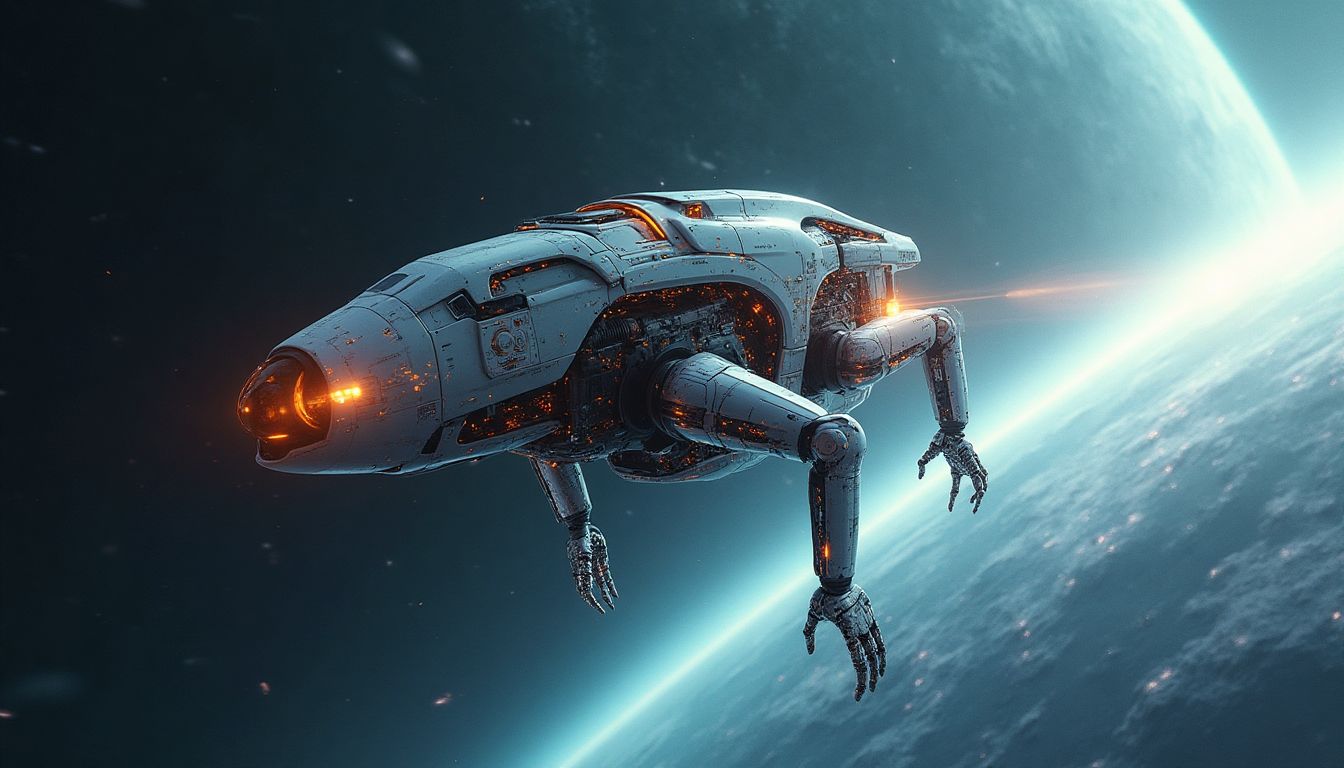Introduction: Beyond the Final Frontier
The cosmos is within us. We are made of star-stuff. We are a way for the universe to know itself. – Carl Sagan. This mesmerizing thought calls us to look beyond our earthly existence. It's about reaching the stars, but now from the perspective of not only human journey but the rise of intelligent machines Carl Sagan (Wiki).
What if the new frontiers of space exploration aren't just human astronauts but machines with the brains to survive in environments where no human dare tread? Enter: intergalactic artificial intelligence, designed to withstand the void and extremes of space. Ready for this cosmic shift?
While Stephen Hawking speculated on time travel among the stars, today's fascination digs deeper into how AI can serve as our trailblazer into the cosmos Stephen Hawking (Wiki).
The emerging stories of AI boldly going where humans haven't ventured are not fictional mumblings but real scientific endeavors, discussed by luminaries like Elon Musk, who dreams of Mars colonies, and Neil deGrasse Tyson, who shares insights on technology's profound potential Elon Musk (Wiki). But are we ready for robots to take the lead through galaxies?
Here, we'll chart the voyage of AI, engineered to brave the cosmos, resilient and resourceful. The human spirit seeks adventure; AI must meet it among the stars.
The Harsh Realities of Space: Conditions and Challenges
Space isn’t just a Sunday stroll through the park; it’s more like a super-duper extreme camping trip with no room for forgetting your tent. The dark void challenges machines with conditions that sound straight out of a sci-fi thriller. Among these scary phenomena: temperatures that range from brain-freeze-cold to sizzling-hot pocket, cosmic rays zipping around like uninvited party crashers, and the absence of gravity making everything floaty.
Extreme Temperatures
Imagine your smartphone exposed to the ice of Antarctica one moment and baked under the Sahara sun the next. Yikes! The conditions vary from chilling -270°C to a toasty 120°C. Machines aren’t yet as adaptable as penguins and cacti, so protecting AI means engineering it to withstand these extreme temperaments.
Radiation Exposure
Radiation in space is like an unruly paparazzi, never giving our artificial comrades a break. Cosmic rays bombard their circuits, threatening with unwelcome photo ops. Engineers need to deal with the sneaky deprecation of hardware, like cinema’s sneaky gremlins causing havoc. Techniques such as shielding are the AI equivalent of high-tech sunglasses.
Vacuum and Pressure Variations
Space doesn’t have any friendly atmosphere waddling around for machines to enjoy. It’s a vacuum, and even minute pressure changes can spell disaster. Imagine a balloon doggie losing its shape without air—AI systems need materials robust enough to keep their forms and functionalities intact.
Microgravity Effects
Let’s get floaty. With microgravity, everything behaves strangely, including the senses! We take gravity for granted on Earth, like the way apples fall. But in space, AI has to adapt without the downward pull. Calculations go loopy; sensors have to rethink their readings. Machines learn to handle topsy-turvy scenarios.
Longevity and Maintenance Challenges
Sending AI into space is akin to the longest long-distance relationship you can imagine. They must be self-reliant as sending a repair technician from Earth (or an Uber) isn't feasible. These are missions that take years, not just a cheeky weekend.
The ongoing challenges of sending AI into space aren't just engineering feasts; they spark our imagination. How will we overcome this cosmic gauntlet? It's more than a matter of nuts and bolts—it's humanity’s old friend ingenuity.
Engineering Resilience: Materials and Design Innovations
As we venture into the cosmos, the need for resilient engineering becomes paramount. Picture a spacecraft harried by cosmic rays, temperatures that make Antarctica look cozy, and the vastness of space that might just swallow you whole—and that's on a good day. In this section, we'll dive deep into the nuts and bolts of crafting indomitable AI systems ready to face these colossal challenges.
Advanced Materials Science
Just like a knight needs armor, AI needs protection. Enter the realm of advanced materials science, a field that's engineering modern-day Excaliburs. Consider aerogels, those funky, featherlight substances that could rival a cloud in density while offering insulation against the brutal cold of space. Or nanomaterials that swagger in like superheroes with nano-sized capes, absorbing radiation and holding back the destructive forces of the vacuum.
Modular Design and Redundancy
Ever had an old floppy disk crash on you? Not pretty. In space, that could spell mission failure faster than you can say "Houston, we have a problem." That's why modular design and redundancy come into play. Here, systems are constructed with interchangeable parts and backups (yes, think R2-D2 and his secret gadgets). Imagine if you could swap out a K-Cup in your machine with such ease—it's the same concept, but with space-tech flair.
Thermal Management Systems
Heating and cooling a spacecraft isn't as simple as adjusting your office thermostat. Out-there thermal management involves everything from passive systems like heat pipes that whisper heat away to active systems that manage heat flow dynamically and efficiently. It's like smart air conditioning for space robots—the luxury suite of thermal solutions.
Radiation Shielding Techniques
If cosmic rays are like tiny invisible arrows, then shielding techniques are the force fields of the future. Recent research showcases advancements in protective barriers for sensitive circuit boards and processors. One could imagine a superhero's shield, deflecting hazardous energy that might well have been conjured by a villain in a comic book saga!
Evolution of Communication Systems
Communication systems have gone from shouting into the void to simply sending a "Yo, Earth, look at this Milky Way selfie!" Space exploration communications, such as those developed by NASA, now involve data relay satellites, enhanced bandwidth options, and latency considerations due to, well, light years. Just remember: the call from space may take a while, so don’t hang up too soon!
Autonomy and Decision-Making: AI's Cognitive Capabilities
One small step for a rocket, one giant leap for thinking machines! Equipping AI systems with decision-making capabilities involves more than just soldering circuits; it taps into the very essence of cognition, fused with a bit of imagination and technical wizardry. Ready to meet these cosmic masterminds?
Machine Learning in Space Missions
Machine learning has grown from a cryptic tech buzzword to a space-age innovation that's literally out of this world. For instance, the algorithms designed for space missions adapt to their environments by learning patterns and recognizing anomalies faster than a toddler eyes up pizza on a high chair tray, adjusting maneuvers on-the-fly in the great inky sea of space.
Sensor Technologies
Advanced sensor technology provides the eyes and ears for our interstellar voyagers, beaming back critical data and communicating in ways that make sonar seem primitive. These sensors can detect chemical signatures, surface vibrations, and, most importantly, whether the onboard coffee is brewing, ensuring the AI remains both informed and energetic!
Human-Machine Interface
In the world of AI-human collaborations, interfaces are like the chains of command. Picture a spacecraft's bridge where the captain (a human, of course) and its AI counterpart exchange data, insights, and one-day movie recommendations. User-friendly data control interfaces make sure operators back on Earth aren't left playing cosmic charades, guessing at AI's enigmatic plans.
Problem Solving in Unique Environments
From dodging space rocks to data overloads, AI must be adaptable and savvy problem-solvers, much like cats learned to master gravity. This capability flourishes in space missions, where algorithms adjust to never-before-seen puzzles and serve alternative outcomes with the finesse of a tuned jazz improv session.
Ethical Considerations
In a universe where AI can act independently, the need for ethical guidelines climbs the charts. While no AI has expressed grand plots to overthrow their creators (yet), accountability in decisions—like who maintains space hygiene—is a growing concern. Balancing the delicate dance of autonomy with accountability mirrors a mirrorball-toting disco night.
Prototyping and Testing: Preparing AI for Space
When it comes to sending AI into space, merely designing machines that are theoretically capable of enduring extreme conditions isn't enough. Rigorous prototyping and testing are critical to ensure that these AI systems function flawlessly when they are millions of miles away from assistance. So, how do engineers mimic the harsh environment of space on Earth? Let's dive in.
Simulated Space Environments
Creating Earth-based simulations of space conditions is no small feat. Thermal-vacuum chambers replicate the low-pressure and temperature fluctuations of space. These chambers allow researchers to observe how AI systems respond to vacuum conditions and extreme temperatures, ensuring that components can handle these stresses before being launched. Meanwhile, exposing AI systems to controlled radiation helps engineers study potential degradation and recalibrate shielding techniques.
Iterative Development and Prototyping
The road to resilience is a winding one filled with trial and error. Engineers often rely on iterative processes, where they design, build, test, and refine. Each cycle of prototyping offers fresh insights: What works? What doesn't? Updating the design means each new iteration edges closer to a system that can take on the great expanse of space.
Collaboration with Space Agencies
Partnerships are the backbone of successful space exploration. Organizations like NASA and the European Space Agency (ESA) bring decades of experience to the table. By leveraging resources, knowledge, and infrastructure, collaborations amplify the potential for groundbreaking discoveries in space-capable AI technology.
Observational Learning from Previous Missions
Past missions serve as a treasure trove of data and learnings. The Mars rovers and Rosetta missions have provided invaluable data on operational challenges and system responses in space. Engineers draw upon these lessons, tweaking AI designs to ensure future missions avoid past pitfalls.
Future Testing Protocols
The landscape of space exploration is ever-evolving, and so is the methodology for testing AI systems. Innovations in AI require advancements in testing paradigms, with a focus on real-time adaptability, longevity assessments, and multi-scenario simulations to replicate the unpredictable nature of space.
Case Studies: Successful Applications and Missions
In the vast theater of space, the stars of AI have had their moments in the spotlight. The following case studies shine a light on the thrilling success stories and innovative applications where AI has prominently played its role.
NASA's Perseverance Rover
The Perseverance rover is more than just a science lab on wheels. Equipped with advanced AI, the rover navigates the rugged Martian terrain autonomously. Its algorithms assess the terrain in real-time, expertly avoiding hazards and selecting routes, enabling it to conduct experiments with minimal human oversight.
ESA's Rosetta Mission
When the Rosetta spacecraft rendezvoused with Comet 67P, it was a milestone for AI in navigation. The mission showcased AI's capacity to make crucial adjustments and predictions, ensuring precise maneuvers around a body with negligible gravitational cues—a testament to calculated autonomy in space.
Deep Space Missions and AI
Deep space missions, like NASA's Voyager probes, have integrated AI for monitoring spacecraft health and autonomously adjusting systems since communication delays can stretch for hours. These capabilities ensure the mission continues unabated, optimizing systems in light of detected anomalies.
AI in Satellite Operations
Satellites circle our planet with the aid of AI systems. These intelligent operators optimize data gathering, adjust orbits based on atmospheric drag, and ensure efficient communication relays. AI's involvement here reflects its prowess in improving mission efficiency and lowering operational costs.
Proposals for Future AI Missions
Looking forward, the horizon is filled with ambitious AI-influenced projects. Concepts include AI-managing bases on other celestial bodies and pioneering explorations in astrobiology. Proposed missions push AI's role from an auxiliary data processor to a chief expeditionary force across the cosmos.
AI Solutions: How Would AI Tackle This Issue?
If I were an AI, I would address these challenges through intelligent design and adaptability by employing the following methodologies:
Establishing self-maintenance protocols
Understanding operational parameters is crucial. An AI should be designed to recognize specific failure modes and initiate self-repair procedures where feasible. This capability ensures continued operational functionality, allowing for prolonged missions without direct human oversight. Imagine an AI autonomous enough to troubleshoot its problems using diagnostic algorithms! Systems could send alerts back to Earth only for severe issues, preserving bandwidth.
Data Assimilation and Learning
AI could implement a multi-tiered learning approach that permits it to accumulate historical data and improve its predictive capabilities. The machine would adapt decision paths based on past outcomes while in unpredictable situations. This could resemble an ever-evolving system that continuously enhances its skills, akin to how humans learn from mistakes and successes.
Cooperative Systems
Creating a network of cooperative AIs would ensure redundancy in decision-making and information sharing across various mission profiles. Picture a scenario where multiple AIs share intelligence gathered during deep-space explorations, thus creating a self-sustaining system capable of greater performance than isolated AIs. Just as scouts work together to report back to a larger group, these AIs would collaboratively tackle challenges faced in space.
Alleviating Hardware Vulnerabilities
Utilizing cutting-edge materials science insights could create robust shells and circuits that dynamically respond to thermal extremes and radiation hazards. Imagine a spacecraft’s outer shell constructed from materials that not only shield against environmental effects but also adapt to internal temperature fluctuations! This imaginative approach could dramatically increase mission longevity and reliability.
Modifying Code in Real-Time
Finally, developing the capability for real-time software updates based on feedback manipulation would enable optimization while in the field. These updates would integrate new problem-solving techniques as they emerge, empowering the AI to learn akin to a computer program evolving with each upgrade. This liberates AI from the constraints of predefined scripts, fostering a system that remains agile and functional as it encounters unprecedented scenarios in space.
Conclusion: The Road Ahead
Intergalactic AI signifies the next great leap in humanity's exploration of the cosmos. The rigorous efforts in the research and development of machines capable of withstanding the tremendous challenges of space reveal not only the innovative spirit of humankind but also raise questions about our reliance on such technology. As we look to the stars, we must prepare ourselves for an epoch where machines not only accompany us on our journeys but also inhabit the distant worlds we seek to explore. Are we truly ready for artificial lifeforms to navigate the vast unknown for us? The answer lies in how we confront the challenges posed by the universe ahead.
Action Schedule/Roadmap (Day 1 to Year 2)
Day 1:
Kick-off meeting with a team of engineers, scientists, and AI specialists at MIT Media Lab and a development team at NASA Jet Propulsion Laboratory (JPL). Define project scope, objectives, and establish communication protocols amongst teams.
Day 2:
Initiate preliminary research into existing materials science and current AI capabilities in collaboration with industry leaders like General Electric and universities such as Stanford University.
Day 3:
Conduct initial brainstorming sessions on potential AI algorithms and machine learning applications tailored specifically for space, compiling insights into a working document.
Week 1:
Set project milestones, establish timelines for research, prototyping, and testing phases. Ensure team alignment regarding goals, deliverables, and expectations.
Week 2:
Begin collaborations with additional top universities, including University of Cambridge, for interdisciplinary insights on AI development tailored to extraterrestrial conditions.
Week 3:
Visit thermal-vacuum test facilities at organizations like NASA's Glenn Research Center to observe existing testing protocols and gather insights to inform future AI designs.
Month 1:
Initiate the development of the first prototype leveraging materials and algorithms founded on early research results, prioritizing durability through modular designs. Include attendance at relevant conferences and workshops.
Month 2:
Simulate AI environments based on anticipated lunar and Martian conditions to refine algorithms, evaluate thermal responses, and assess adaptive behavior in varying scenarios.
Month 3:
Assess initial prototypes offering valuable feedback, and adjust designs and algorithms to enhance resilience in dramatic environments that mirror space conditions.
Year 1:
Achieve development of a robust AI prototype capable of surviving extreme conditions. Evaluate the interoperability with existing robotic systems through extensive field tests.
Year 1.5:
Critically assess performance against predefined benchmarks while engaging in evolutionary programming to enhance capabilities in preparations for actual space mission assignments.
Year 2:
Final testing phase precedes deployment. Conduct comprehensive stress tests in simulated space conditions, ensuring robust backup protocols and safety nets are fully developed to guarantee reliability.
FAQ
Q: What makes AI suited for space exploration?
A: AI is perfect for space exploration because it can process huge amounts of data very quickly and make decisions without needing a human to tell it what to do. In space, there’s often no one around to help, so AI can work independently to make smart choices.
Q: How do engineers ensure AI systems are resilient in space?
A: Engineers use special materials and smart designs to make sure AI can handle the tough conditions of space. For example:
- Advanced materials: Materials that can withstand extreme temperatures.
- Modular designs: Parts can be replaced easily if something breaks.
- Thermal management: Systems that manage heat to keep everything running smoothly.
- Radiation shielding: Protects AI parts from harmful radiation.
Q: What are some challenges faced by AI in space exploration?
A: AI encounters several challenges, including:
- Extreme temperatures: Ranges from super cold to very hot.
- Radiation exposure: Cosmic rays can damage AI systems.
- Vacuum conditions: Lack of air can affect how machines work.
- Microgravity: Changes how AI sensors and parts function.
- Long-duration operations: AI must keep working without help for a long time.
Q: Will AI change the way we explore space?
A: Yes! AI can make space missions smarter and faster by:
- Helping with navigation: AI can choose the best route to take.
- Analyzing data: It quickly looks at data from space to help scientists understand what’s out there.
- Learning and adapting: AI can learn from experience and make adjustments to improve its performance.
Q: Are there any examples of successful AI in space missions?
Definitely! Some great examples include:
- NASA's Perseverance Rover: This rover uses AI to navigate Mars and conduct experiments.
- ESA's Rosetta Mission: It used AI to land on a comet and study it closely.
- Deep Space Missions: Several long-duration missions have successfully integrated AI to monitor spacecraft systems.
Q: Can AI understand its own mistakes?
Yes! AI can learn from its errors through a process called machine learning. It analyzes what went wrong and adjusts its future decisions to avoid making the same mistake again.
Q: What are some positive impacts of using AI in space exploration?
- Safer missions: Reduces risks for humans by sending AI instead.
- Better data collection: AI can gather and analyze information faster than humans.
- Exploration of unreachable places: AI can go to environments that are too extreme for people.
- Cost-effective: Reduces costs by automating repetitive tasks.
Q: Who is working on developing AI for space?
Many organizations are involved, including:
- NASA: The U.S. government agency responsible for the nation's civilian space program.
- European Space Agency (ESA): An intergovernmental organization dedicated to the exploration of space.
- Jet Propulsion Laboratory (JPL): A research and development center that works on robotic space missions.
Wait! There's more...check out our gripping short story that continues the journey: The Ending of the Light
Disclaimer: This article may contain affiliate links. If you click on these links and make a purchase, we may receive a commission at no additional cost to you. Our recommendations and reviews are always independent and objective, aiming to provide you with the best information and resources.
Get Exclusive Stories, Photos, Art & Offers - Subscribe Today!





























Post Comment
You must be logged in to post a comment.